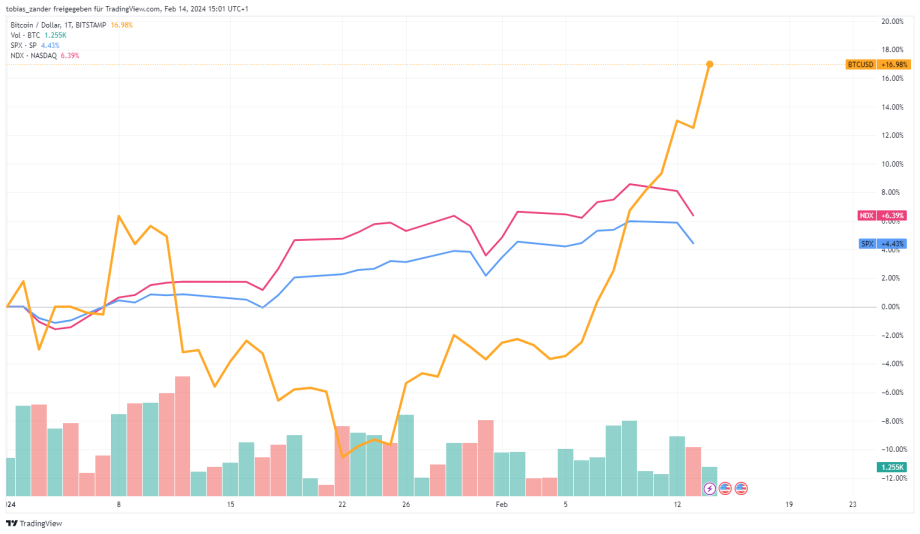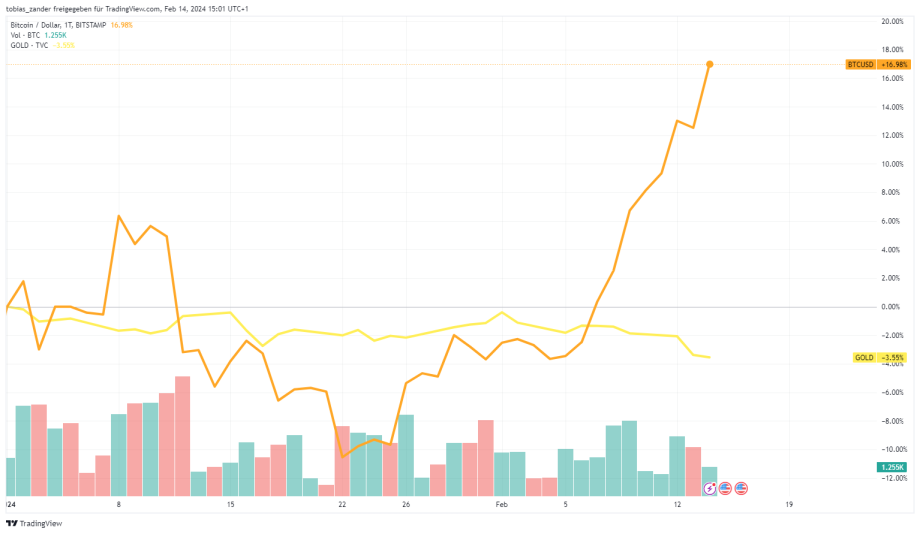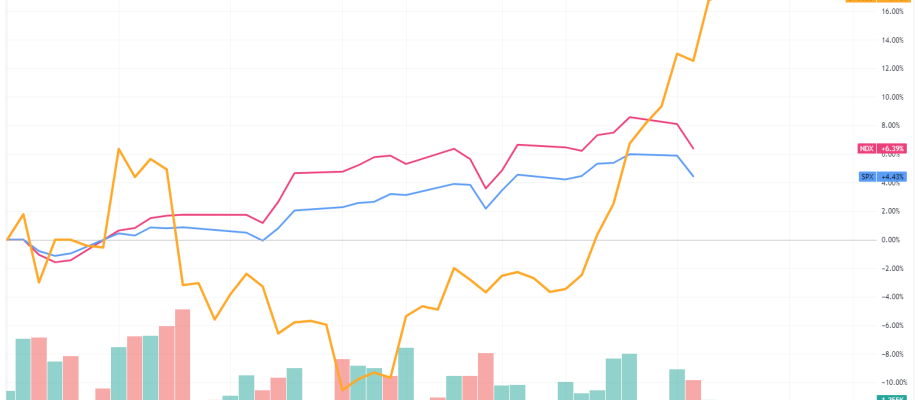The new US inflation data from Tuesday has temporarily changed the mood on the stock markets. According to the US Department of Labor, prices rose 3.1 percent compared to last year. Experts originally expected a decline to 2.9 percent. Inflation is proving to be more persistent than expected, which is why American stocks fell significantly. The price of gold also disappointed and fell below the $2,000 mark. Meanwhile, Bitcoin continues its upward trajectory seemingly unstoppable and shakes off its positive correlation with other asset classes. But 2024 could still have big surprises in store. What does ongoing inflation mean for the capital markets, where does Bitcoin’s strength come from and what happens next?
US stock markets and gold with losses
The market-wide S&P500 index closed with a loss of 1.4 percent after the announcement of the US inflation data, while the technology-heavy NASDAQ-100 fell by 1.8 percent. With the recent inflation data Hopes of an early easing of interest rate policy are dwindling. The likelihood of a cut in the key interest rate by the US Federal Reserve (Fed) is currently at the beginning of May only 34 percent. Above all, the high core inflation rate without taking into account the more volatile food and energy prices is a concern because it remained at 3.9 percent on an annual basis.

Things have actually been going well on the traditional capital markets since the beginning of the year. The S&P500 even broke through the symbolic 5,000 mark for the first time a few days ago. The NASDAQ-100 also developed, not least due to the performance of the “Magnificent Seven” very positive. But the setback after the announcement of the inflation rate suggests that the price growth had already priced in an imminent downward turn in interest rates. Bitcoin, on the other hand, was unconcerned and even broke the $51,000 mark in the morning. This means that BTC is now one of the trillion-dollar assets again.


While digital gold continues its rise, traditional, physical gold is weakening. The precious metal is actually considered a classic instrument for hedging against inflation. Nevertheless, gold has also lost 1.8 percent since the inflation data was announced, measured in US dollars. Bitcoin, on the other hand, gained over 3 percent. If you look at it since the beginning of the year, the difference becomes even more serious: while gold lost around 3.5 percent, the digital challenger was able to rise by over 16 percent. This could not least be because Bitcoin has dominated the headlines for weeks and has pushed physical gold out of the spotlight. Not good news for gold bugs like Peter Schiff, whom BTC-ECHO interviewed exclusively in July 2023.
Why Bitcoin Remains Unfazed
Federal Reserve officials said they are currently cutting interest rates don’t be in a hurry and wait for convincing evidence that the fight against inflation has been successful. But Bitcoin is apparently not currently dependent on low interest rates and correspondingly risk-taking investors. In the long term, there is a clearly positive correlation between the Bitcoin price and the money supply, but other factors are currently making the interest rate issue take a back seat. Above all, the ongoing buying pressure from Bitcoin ETF providers and the associated entry of institutional investors are driving the BTC price upwards.
But other factors also ensure Bitcoin’s amazing strength. The selling pressure from the Grayscale Bitcoin Trust (GBTC) that lasted for weeks has now subsided and the BTC holdings on the crypto exchanges are melting because private investors are storing their coins themselves and “hodling” them in a disciplined manner. At the same time, Chinese New Year traditionally brings fresh capital from Asian investors into the market. The resulting bullish sentiment will ultimately be further fueled by the upcoming Bitcoin halving in April. In the past, halving often signaled the start of a new bull market.
Since January 1, 2023, the Bitcoin price has risen over 210 percent (!) in US dollars. Nevertheless, it is difficult to find good arguments against a positive development in the current market environment. As a result of the recent rally, BTC is already among the ten most valuable assets in the world, although institutional investors are only just beginning to approach it. This strength is impressive and could well have a self-reinforcing effect. The following applies: the less Bitcoin correlates with other assets, the more attractive the alternative store of value becomes for portfolio diversification. This in turn could lead to a price increase that would make BTC more attractive again. And we would be right in the middle of the next hype cycle.
This might also interest you
